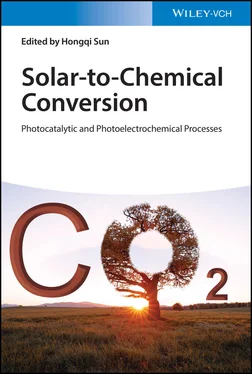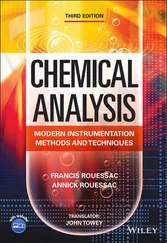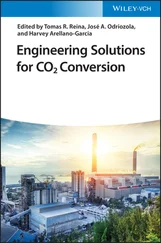12 Chapter 13Figure 13.1 (a) The kinetic progress of methaneactivation on thermocatalysis and photocatalysis methods, (b) reaction mechanism of photocatalysis, and (c) reaction mechanism of photoelectrochemical catalysis. Source: Song et al. [2].Figure 13.2 (a–d) Photoexcitation and subsequent relaxation processes following the illumination of a metal nanoparticle with a laser pulse and characteristic time scales. Source: Brongersma et al. [28]Figure 13.3 (A) Schematic (a) a conventional vacuum line equipped with pressure gage; (b) joint; (c) small hole for thermo‐couple; (d) catalyst bed; (e) UV‐reflection mirror; (f) Xe lamp. drawing of the fixed bed photo‐reactor. Source: Yoshida et al. [46]Figure 13.4 (a) Difference on activation energy between photocatalysis and thermocatalysis. Source: Chen et al. [5], licensed under CC BY 4.0Figure 13.5 (a) Proposed mechanisms of photooxidation of CH 4on TiO 2. Source: Li et al. [26] © 2018, American chemical society
13 Chapter 14Figure 14.1 Composition of biomass.Figure 14.2 (a) Reaction process images, quantification, and distribution of products obtained from the photocatalytic depolymerization of birch lignin. (b) Proposed mechanism for β‐O‐4 bond cleavage in the photocatalytic conversion of lignin over the Zn 4In 2S 7catalyst. Source: Reprinted with permission from Lin et al. [27].Figure 14.3 Photographs taken before (a) and after (b) precipitation of lignin during photoelectrocatalytic oxidation of 500 ppm lignin at different times, (c) Fourier transform infrared (FTIR) spectra of lignin and modified lignin, and (d) intermediates analyzed using HPLC. Source: Reprinted with permission from Tian et al. [48].Figure 14.4 Illustration of experimental reactor used for photoreforming cellulose to hydrogen via combined photocatalysis and acid hydrolysis. Source: Zou et al. [56].Figure 14.5 Photothermally promoted cleavage of β‐1,4‐glycosidic bonds of cellulose on Ir/HY catalyst. Source: Reprinted with permission from Zhang et al. [57].Figure 14.6 Schematic representation of the photocatalytic system for the H 2evolution by water splitting over irradiated Pt/TiO 2in the presence of cellulose as the sacrificial agent. Source: Speltini et al. [62], licensed under CC BY 3.0.Figure 14.7 Photocatalytic H 2production using activated NCNCN x(5 mg) and Ni bis(diphosphine) (NiP) (50 nmol) with purified lignocellulose components (100 mg) in potassium phosphate (KPi) solution (0.1 M, pH 4.5, 3 ml) under AM 1.5 G irradiation for 24 hours at 25 °C. Source: Kasap et al. [68].Figure 14.8 Schematic illustration of the lignocellulose structure and photocatalytic valorization of native lignin. Source: Reprinted with permission from Wu et al. [70].Figure 14.9 (a) Scanning electron microscope (SEM) image of sample Bi 2WO 6; (b) Time‐online photocatalytic performance toward selective oxidation of glycerol to DHA over Bi 2WO 6. Source: (a) Reprinted with permission from Zhang et al. [74]; (b) Zhang et al. [74].Figure 14.10 A simple solar‐induced hybrid direct glycerol fuel cell consists of a Pt cathode, a Na‐Pi buffer electrolyte with glycerol as fuel and NiPi/Pi–Fe 2O 3as a photoanode, and the possible photo‐generated charging process of glycerol process of glycerol oxidation over NiPi/Pi–Fe 2O 3. Source: Chong et al. [97].Figure 14.11 SEM image of (a) W:BiVO 4and (b) pTTh films. (c) The energy level diagram of the dual‐photoelectrode PFC. Source: (a, b) Modified with permission from Zhang et al. [36]; (c) Zhang et al. [36].Figure 14.12 Schematic configuration and electron transfer processes of PEC glucose/glucose fuel cell employing TiO 2/ITO photoanode and ITO cathode upon incorporation of UV light and MB. Insets show SEM images of TiO 2/ITO and structures of MB and LMB. Source: Zhao et al. [104].Figure 14.13 A plausible reaction mechanism of PEC selective aerobic oxidation of benzyl alcohols. Source: Zhang et al. [112].Figure 14.14 A photoelectrochemical cell for HMF reduction. Inset is the SEM image showing the surface morphologies of Ag gd. Source: (a) Roylance et al. [116]; (b) Reprinted with permission from Roylance et al. [116].
14 Chapter 15Figure 15.1 Schematic illustration of electron–hole pair generation in a semiconductor upon light irradiation. Possible pathways are labeled in 1– 4, where 1, reduction; 2, oxidation; 3, volume recombination; and 4, surface recombination; A, electron acceptor, and B, electron donor. Source: Linsebigler et al. [4].Figure 15.2 Schematic illustration of different photocatalytic water splitting systems. (a) One‐step photoexcitation or single‐component photocatalytic system. (b) Photocatalytic system with type‐II heterojunction. (c) Two‐step photoexcitation or Z‐scheme photocatalytic system. Source: Chen et al. [6].Figure 15.3 Possible configurations of CO 2absorption on the surface of photocatalysts. Source: Liu et al. [12].Figure 15.4 Bandgap energies and the band edge positions of some commonly reported photocatalysts as well as the products derived from photocatalytic CO 2reduction with reference to normal hydrogen electrode (NHE). Source: Tu et al. [10].Figure 15.5 (a) Photoanode–HEC cathode, (b) photocathode–OEC anode, (c) photoanode–photocathode tandem cell, and (d) photoanode–photovoltaic (PEC‐PV) tandem cell. Source: Kim et al. [1].Figure 15.6 Schematic illustration of side‐irradiated water splitting reactor. Source: Takata et al. [23].Figure 15.7 Schematic illustration of top‐irradiated water splitting reactor. Source: Kudo et al. [25].Figure 15.8 (a) Schematic illustrations of inner‐irradiated reactor in lab scale. Source: Wei et al. [27].Figure 15.9 Schematic illustration of a twin photo‐reactor system. Source: Sasaki et al. [29].Figure 15.10 Schematic illustration of photocatalytic water splitting panel. Source: (a) Reproduced with permission Goto et al. [30]. Copyright 2018, Elsevier; (b) Goto et al. [30].Figure 15.11 Schematic illustration of (a) slurry reactor, (b) internally illuminated reactor, and (c) optical fiber reactor. Source: Ola et al. [35], licensed under CC BY 4.0.Figure 15.12 Schematic diagram of photocatalytic CO 2reduction in a continuous gas flow fixed bed reactor. Source: Kong et al. [7].Figure 15.13 Schematic diagram of PEC water splitting system in the configuration of (a) n‐type photoanode‐HEC and (b) p‐type photocathode‐OEC. Source: Ahmed et al. [40].Figure 15.14 Schematic diagram of PEC water splitting devices: (a) with membrane and (b) without membrane. (c) Photograph of an integrated membrane‐free device with internal wiring. Source: Reproduced with permission Jin et al. [41]. Copyright 2014, Royal Society of Chemistry.Figure 15.15 Schematic diagram of PEC CO 2reduction system. Source: Cheng et al. [42].Figure 15.16 Large‐scale reactor for photocatalytic H 2production containing immobilized Pt/ g ‐C 3N 4working under natural sunlight. Source: Reproduced with permission Schröder et al. [43]. Copyright 2015, Wiley.Figure 15.17 (a) Schematic illustration of synthesis protocol of SrTiO 3:La,Rh/Au/BiVO 4:Mo Z‐scheme photocatalyst sheets using particle transfer method. (b) Electron transfer mechanism of SrTiO 3:La,Rh/Au/BiVO 4:Mo Z‐scheme system. (c) Photograph of the ink used for screen printing and the corresponding printed photocatalyst sheets. Source: (a, c) Reproduced with permission Wang et al. [30]. Copyright 2016, Nature Publishing Group; (b) Wang et al. [30].Figure 15.18 (a) False‐colored SEM image of Si/TiO 2nanotree arrays photocatalyst sheets. (b) Photographs of Si/TiO 2photocatalyst sheets. (c) Charge transfer mechanism in Si/TiO 2photocatalyst sheets. Source: Reproduced with permission Liu et al. [44]. Copyright 2013, American Chemical Society.Figure 15.19 (a) Wired PEC cell and monolithic wireless cell of Co‐Bi/3jn a‐Si/NiMoZn system. Source: Reece et al. [45]. Copyright 2011, American Association for the Advancement of Science.Figure 15.20 (a) SrTiO 3‐based artificial leaf with Cu xO as HER co‐catalysts and CoPi as OER co‐catalysts. Source: Reproduced with permission Chen et al. [48]. Copyright 2017, American Chemical Society.
Читать дальше


![Евгений Матерёв - Музеи… или вдохновляющая музыка The Chemical Brothers [litres самиздат]](/books/437288/evgenij-materev-muzei-ili-vdohnovlyayuchaya-muzyka-th-thumb.webp)









